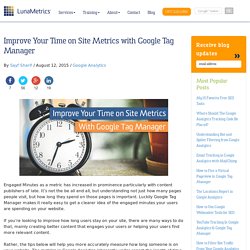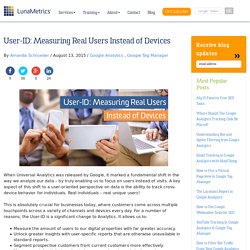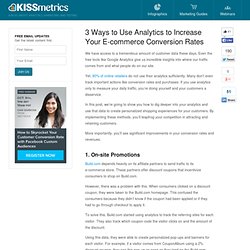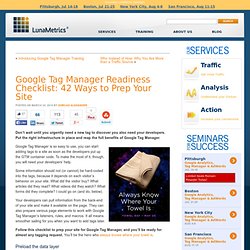

Smarter Insights: 5 Google Analytics Custom Reports FTW! Basic Reporting Automation with Google Analytics. By Andrew Garberson / July 29, 2015 Google Analytics I am not a data scientist.

I don’t even like statistics. That puts me in the extreme minority at LunaMetrics, a company comprised of people who ruined grade points in undergraduate statistics by setting test curves beyond the reach of their mere mortal peers. How to Report Custom Dimensions in Google Analytics. By Dorcas Alexander / August 10, 2015 Google Analytics By now, reporting with custom dimensions is second nature for many of you.

Improve Your Time on Site Metrics with Google Tag Manager. By Sayf Sharif / August 12, 2015 Google Analytics Engaged Minutes as a metric has increased in prominence particularly with content publishers of late.

It’s not the be all end all, but understanding not just how many pages people visit, but how long they spend on those pages is important. User-ID: Measuring Real Users Instead of Devices. By Amanda Schroeder / August 13, 2015 When Universal Analytics was released by Google, it marked a fundamental shift in the way we analyze our data – by truly enabling us to focus on users instead of visits.

A key aspect of this shift to a user-oriented perspective on data is the ability to track cross-device behavior for individuals. Real individuals – real unique users! This is absolutely crucial for businesses today, where customers come across multiple touchpoints across a variety of channels and devices every day. Measure the amount of users to our digital properties with far greater accuracy.Unlock greater insights with user-specific reports that are otherwise unavailable in standard reports.Segment prospective customers from current customers more effectively.More accurately attribute value to key conversion channels by improving upon conversion paths.
Background. Watson Analytics - Marketing. 4 Analytics Every Business Needs To Know About Consumers. 28 May, 2015 According to the May monthly reading from Prosper, consumer confidence is flat month-over-month but up year-over-year.

Planned spending on retail and dining, purchase intentions for autos, and consumer impulsivity are all rising. Among Adults 18+, the May Consumer Confidence reading is at 48.6%, which is relatively flat compared to last month (49.0%) and up 18% from May 2014 (41.0%). Small Business Owners are tracking even higher with a May reading of 54.2%, although down from last month (56.4%).The May Consumer Spending Forecast is up to 83.23 from 81.97 in April and 81.31 in May of 2014. The retailers whose customers are at the high end of the Consumer Spending Forecast are: Gap, Old Navy, Target, Macy’s and Amazon Shoppers. Read full story. 4 Ways Real-Time Analytics Lead To Competitive Advantages. 10 Hidden Gems In Google Analytics: Smart Web Data Analysis. Brand Campaign Groups in AdWords Beta. By Stephen Kapusta / April 15, 2015 Paid Search Have you seen the brand campaign groups featured in your AdWords account?

It’s still early but this seems like a great high-level analysis tool for any advertisers interested in building their brand. You can roll together your display targeting and video campaigns into a single campaign group for easy spend analysis. This reporting feature places more emphasis on awareness-oriented metrics and interactions like impressions, views, and ad engagement. Creating and Reporting on Brand Campaign Groups. Methods to Strip Queries from URLS in Google Analytics. By Samantha Barnes / April 17, 2015.

Rebecca Wissinger sur Twitter : "94% of CMOs recognize #analytics as "The Future of Work." #NewWayToWork. The Future of Work: Analytics. New Spam Keyword "resellerclub scam" How to Use Google Analytics Behavior Reports to Optimize Your Content. Do you want to know what content performs best on your website?

3 Ways to Use Analytics to Increase Your E-commerce Conversion Rates. We have access to a tremendous amount of customer data these days.

Even the free tools like Google Analytics give us incredible insights into where our traffic comes from and what people do on our site. Yet, 80% of online retailers do not use their analytics sufficiently. Many don’t even track important actions like conversion rates and purchases. Google Tag Manager Readiness Checklist: 42 Ways to Prepare. Don’t wait until you urgently need a new tag to discover you also need your developers.

Put the right infrastructure in place and reap the full benefits of Google Tag Manager. Google Tag Manager is so easy to use, you can start adding tags to a site as soon as the developers put up the GTM container code. To make the most of it, though, you will need your developers’ help. Some information should not (or cannot) be hard-coded into the tags, because it depends on each visitor’s behavior on your site.
What did the visitor buy? Your developers can pull information from the back-end of your site and make it available on the page. Creative Tag Manager – Ads, Promotions, and Visitor Messaging. Let’s get creative with Google Tag Manager! Google Tag Manager has changed the way we implement Google Analytics here at LunaMetrics, making it easier to track pageviews, events, you name it. It’s excellent for adding marketing tags for Adwords or conversion tracking for any service you need.
But many people gloss over the fact that GTM can deliver really any code that you want to your site. This includes HTML, CSS, and Javascript! iPassExam - Practice Questions for Google Exams. Tips and tricks on passing the Google Analytics Individual Qualification (GAIQ) test. Yesterday, I passed the Google Analytics Individual Qualification (GAIQ) test with a score of 91%. It’s a 70 question online exam which you have an hour and a half to complete and you have to get 80% to pass (Google recently increased the pass rate from 75% and the reduced the time allowed by 30 minutes).
I didn’t find this to be too much of an issue as I still had 15 minutes spare. The test comprises of multiple choice questions, usually with 4 answers to choose from. Some however, are the ‘check all that apply’ type, which I found the trickiest. Preparing for the GAIQ test Before you take the GAIQ exam, the best resource for preparation is Google’s Conversion University lessons, which are broken down in to easily digestible segments.
My test included a lot of Adwords related questions, which although is covered in the lessons I think I would have struggled a bit if I was not familiar with running campaigns. During the GAIQ test The best tool was the Conversion University itself. How to Pass the Google Analytics IQ Test in Two Days: Zero to Hero. I am going to tell you how to study for and pass the Google Analytics Individual Qualification (GAIQ) test in two days. But, why should you listen to me? I’m just a lowly intern, right? Not only did I manage to go from zero GAIQ experience to passing the test with 94% in two days, but I also spent 3 years as a professional ACT instructor at a leading test prep company. The GAIQ is a valuable certification that absolutely always results in multiple job offers, Oscar nominations, and your old boss begging to have you back.
Failure results in … we won’t get into that because failure is not an option. So, what will this post help you accomplish? Test Overview The GAIQ test is 90 minutes and 70 questions long, consisting of both multiple choice and True/False questions. Google Analytics and Cookies - The Complete Guide. It is likely, whether you are in the industry or not, you have heard the term ‘cookie’ thrown around here and there – And unfortunately I don’t mean the chocolate chip kind.
A cookie is a small text file which is stored in your browser as a means of giving memory to browsers and servers. Originally created to help maintain customisation, the cookie contains data which is attached to the HTTP header of a page request, allowing the server to determine if you have any current customisations in place and whether or not you have the authority to view the page. Google Analytics relies on cookies to ‘remember’ and record a users’ interaction on a website. In this blog post I am going to look at each of the specific cookies Google Analytics uses, the potential customisations and a way of using Google Debugger to see the cookie data.